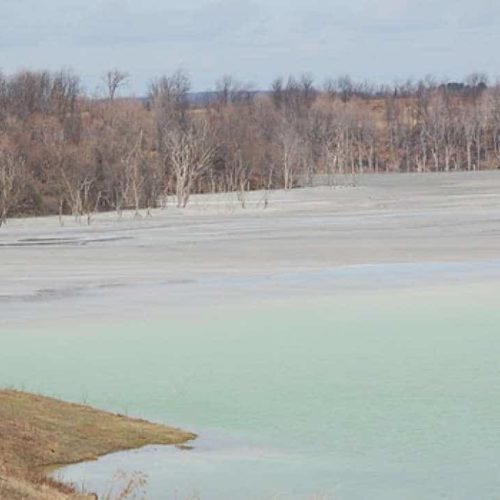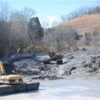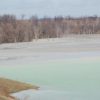Introduction

Stand before the pond known here in southwestern Pennsylvania as Little Blue Run, and you’ll see nothing that resembles its bucolic-sounding name.
The one-time stream is now an industrial pond, filled with arsenic-laced waste from a coal-fired power plant. The pond spans nearly 1,000 acres of rolling, rural landscape in Pennsylvania and West Virginia, along the Ohio River. Millions of tons of coal ash have landed in the 35-year-old dump, looming over some 50,000 people in southeastern Ohio, held back by a 400-foot-tall dam, that federal regulators have deemed a “high hazard” to human life if it ever let loose.
Here in tiny Greene Township, where the pond consumes more than 10 percent of the total land, Little Blue Run seems a wasteland.
Coal ash, tinted blue, has overtaken the valley, rising each year by a million tons, blanketing the trees so they look like pixie sticks. Residents say dry ash wafts into their yards, its sulfuric smell burning their throats. At night, they hear a swooshing sound as coal ash cascades down a pipe stretching seven miles from the Bruce Mansfield Power Station, in Shippingport, Pa.
“It will keep rising,” says Marci Carpenter, who lives in a neighborhood dotted with vacant properties and abandoned homes, “and soon it’ll be above my house.”
Unless, that is, coal ash is regulated by the federal government.
In May, the U.S. Environmental Protection Agency unveiled a proposal to begin regulating the disposal of coal ash — an environmental hazard highlighted in a Center for Public Integrity investigation last year. The Center’s probe revealed the havoc that coal ash has wreaked on the environment and on human health near ponds, landfills, and pits where it gets dumped, while a debate over federal regulation dragged on for decades.
That debate flared anew after a disastrous December 2008 coal-ash spill in eastern Tennessee. The EPA reacted by pledging to regulate the toxic byproduct of burning coal to produce electricity. The agency has also approved a $268 million, four-year plan to remove coal ash from the Tennessee site, but some estimates put the total clean-up price at $825 million — and counting.
EPA Considers Two Options
Friday is the deadline set by the EPA for electric utilities, farmers, scientific experts, and ordinary citizens to offer suggestions on the agency’s 563-page draft plan, which includes two options.
Under the toughest option, the agency would essentially classify coal ash as “hazardous,” triggering a series of strict controls for its dumping. The EPA’s second option would deem coal ash “non-hazardous,” and subject it to less stringent national standards that amount to guidelines for the states.
In recent months, hundreds of people have shown up, some by the busload, in locales like Denver, Dallas, and Chicago, to testify at a series of all-day hearings on the agency’s proposal. The EPA says it has received more than 200,000 comments on its plan to date. And more is surely coming. The EPA will spend the coming months reviewing the public comments before finalizing its plan.
Worries About Drinking Water
For many following the debate in this Appalachian valley, Little Blue Run epitomizes the need for federal regulation. Residents believe their well water has grown increasingly tainted with coal ash, and they tick off a host of ailments — allergic reactions, cancers — they fear has come from living in its shadow.
Their concerns are not misplaced. Nestled in a farming community relying on well water, Little Blue Run is just the kind of unlined ash site that the EPA says poses a cancer risk from arsenic levels 900 times above what is deemed safe. Environmental groups have singled out the pond as one of 70 cases in 35 states where they claim coal ash has caused severe degradation.
In an August report, the Sierra Club, EarthJustice, and the Environmental Integrity Project documented how many of coal ash’s toxic components linked to health problems — arsenic, cadmium, and lead, for instance — are higher than permitted in drinking water around the massive dumpsite.
FirstEnergy Corp., owner of the Bruce Mansfield plant and its coal ash pond, disputes such findings of drinking water contamination, as does the Pennsylvania Department of Environmental Protection (DEP).
Company and state officials alike acknowledge the ash has affected groundwater on site. In fact, the DEP alerted FirstEnergy in a Feb. 16 letter that “elevated levels of Arsenic were detected” in 10 of 42 monitoring wells stationed around the pond — the second letter the department has issued since 2007. But this on-site contamination, they say, has not spread to the area’s drinking water.
“The key issue is the drinking water wells,” says Mark Durbin, of FirstEnergy, noting the company has never detected pollution in the 70 residential wells it has tested. “There has not been an impact on any drinking water well caused by Little Blue Run.”
Tell that to Barbara Reed, of Chester, W.Va., who lives a mile and a half from the pond.
Back in 1975, when the Little Blue Run stream was essentially taken for the pond — impounded — she, like other residents, remembers the former operators promising the community that the ash pond would be turned into a recreational park, where residents could hike, bike, and picnic. “Nobody told us, ‘We’re going to drop ash water with lead, arsenic, thallium, and other toxins into your backyard,’” she recalls.
Her son, John, owns a modest, wooden house located about 1,000 yards from the pond, which he spent years fixing. Reed says he has abandoned his property after tests, conducted by FirstEnergy in October 2008, detected arsenic above the maximum level allowed in his well water. Tests by the state found arsenic at similar levels — 14.6 micrograms per liter, as compared to the safety standard of 10 µg/L. A copy of the January 2009 results shows high amounts of thallium, manganese, iron, and aluminum, as well.
“We all drank this water,” Reed says, standing in front of her son’s now-shuttered home, “and we had no idea we were being poisoned.”
FirstEnergy, State Say Drinking Water Safe
FirstEnergy’s Durbin says the company has since re-tested the Reed well, which revealed arsenic at “barely detectable” levels. He calls the first tests “bad,” or “mistests,” due to cloudy water. State regulators report similar findings, saying the Reed well is not “hydrogeologically connected” to the pond, and pollutants affecting the water’s taste and smell are “very common” in the area.
“There is no evidence of primary constituents getting into the area’s drinking water supplies,” says Jeffrey Smith, a state geologist who has sampled water from 28 private wells since 2004, including Reed’s. The department is now investigating whether there is evidence of “secondary contamination,” it says.
Documents provided to the Center by environmental advocates suggest as much.
Lisa Widawsky, the EIP attorney who compiled the August report on Little Blue Run, collected public and private records from 22 residents, including Reed. They show high levels of pollutants like barium, cadmium, and chloride detected not just in residential wells, but also indoor faucets. In fact, the state itself ordered FirstEnergy’s predecessor, Pennsylvania Power Co., to replace one resident’s tainted drinking water because, the June 21, 1994, letter states, “it is very probable that the impoundment is responsible for the adverse effect on the water supply.”
“For both to deny that’s evidence of drinking water contamination,” Widawsky counters, “they’re not being very truthful.”
Over in Lawrenceville, W.Va., where the coal ash has been dried and seeded with grass, residents face a different problem: It’s “an unauthorized seep,” says Merle Byart, a 38-year resident, standing before a rush of water coming off the hillside, where Little Blue Run sits, and into his backyard.
Byart, like many neighbors, noticed his water turn “bad” after 2006, when FirstEnergy got permission from the state to expand the pond by stacking its coal ash. Not long ago, he cleaned his garage, washed his hands, and made his coffee with his water. Today, he worries about its gritty sediment, its “rotten eggs” stench. He believes the ash has been piled so high that ash-laden water is seeping into his yard — a possibility the company does not dispute.
“It could be any number of factors,” FirstEnergy’s Durbin says, referring to Byart’s seep. “The bottom line is we’re aware of it, and we have a plan to try to be a good neighbor.”
FirstEnergy has tested Byart’s water, including the seep, finding elevated levels of sulfates, iron, and total dissolved solids. “It’s not uncommon to have a spring or seep out of the ground from the pond,” says Durbin. State regulators have a standing consent order against FirstEnergy requiring the company to collect any ash water leaking from Little Blue Run, and direct it back into the pond.
The state, which inspects the pond monthly, has asked FirstEnergy to monitor increasing flow in the area. Still, the DEP’s Smith states, “There is nothing conclusive yet,” connecting that flow to the pond.
Heavy Lobbying by Utilities
If the EPA implements its strictest proposal for coal-ash disposal, FirstEnergy would have to shutter its wet pond — for good. Durbin says the company wants “consistency across states,” but not a “hazardous” label. Like other utilities, FirstEnergy argues that state regulators already provide careful oversight of coal ash.
Utility trade organizations and other industry players have lobbied hard against federal regulation. Even before the EPA released its current proposal, officials at the Office of Management and Budget — an arm of the White House — had held more than 40 meetings on the issue dating back to October 2009, when the EPA sent OMB a draft favoring the hazardous approach. Most of the closed-door meetings were with electric utilities and their allies, such as state associations.
Michael Forbeck, of the Pennsylvania DEP, defends the idea of state oversight; he testified against federal regulation at a September hearing, in Pittsburgh. Currently, Pennsylvania manages coal ash as a solid waste, requiring such protections as liners and groundwater monitoring — which, he says, is more rigorous than what EPA proposes under its second option.
FirstEnergy plans to shutter its wet pond within five to eight years, he points out, regardless of what rule the EPA ends up implementing. He insists the state would never allow a stream to become an impoundment today.
“That was done in the ’70s,” Forbeck says, “and we’ve had to live with that.”
For many residents, living with Little Blue Run has left them feeling, in the words of Byart’s neighbor, Deb Havens, “stuck.” Every day, they worry about their water, their air, their health. Every day, they wonder how they can afford to leave when the pond has devalued their properties. Even if the EPA implements the tougher option, they say, it cannot reverse the environmental destruction that has already taken place.
Standing before Little Blue Run and its gray-blue muck, Havens’ eyes well up. “I don’t want this view. I don’t want to see it,” she says. “I’d rather be dead.”
Read more in Environment
Environment
NEPA exemptions: The dirty dozen list
Environment
Big polluters freed from environmental oversight by stimulus
BP, Westar, and DuPont Among Companies Exempted from Environmental Law








Join the conversation
Show Comments